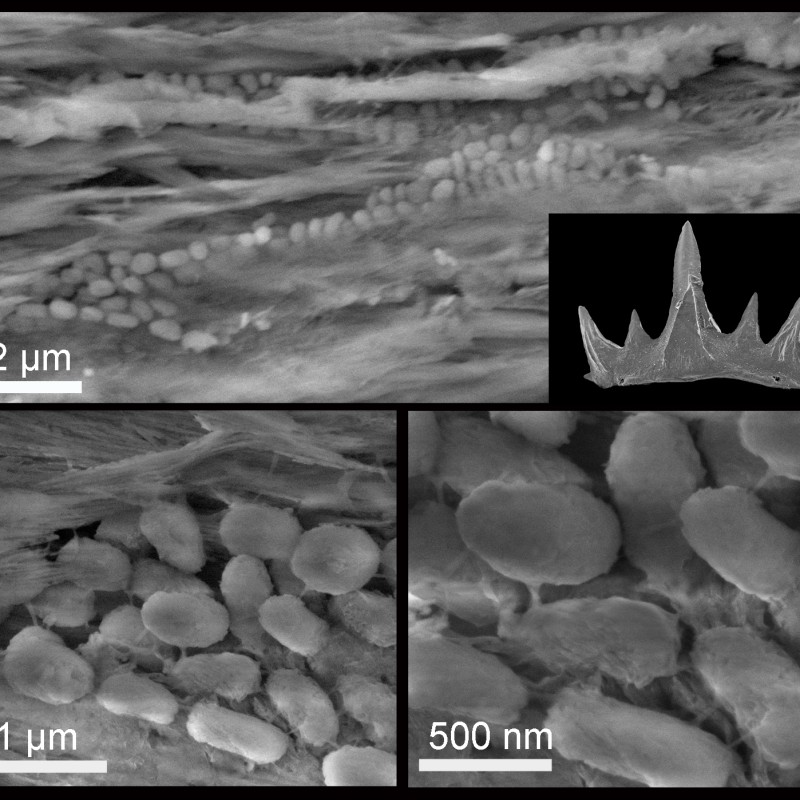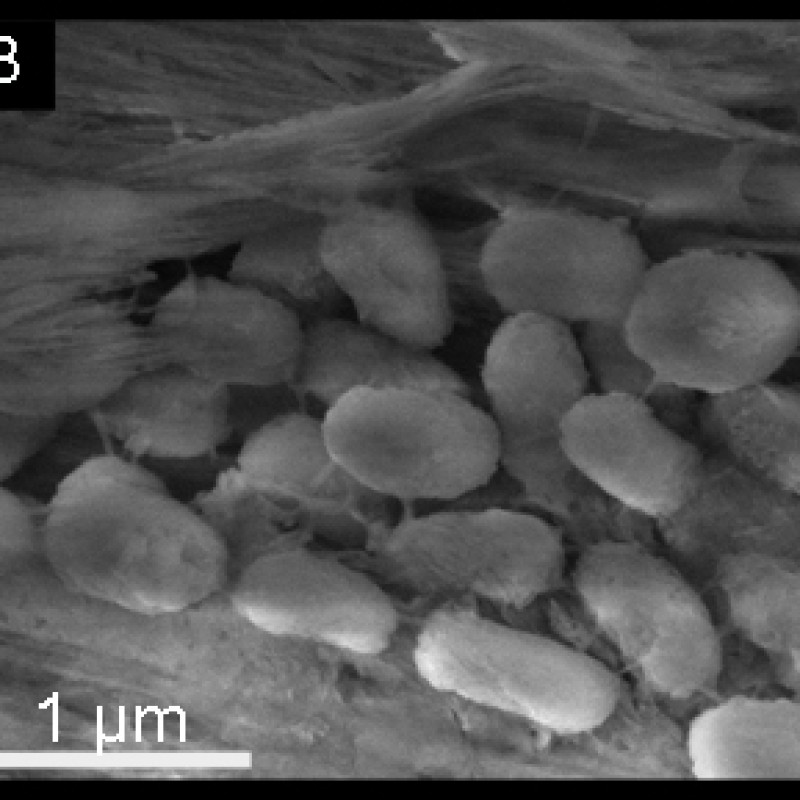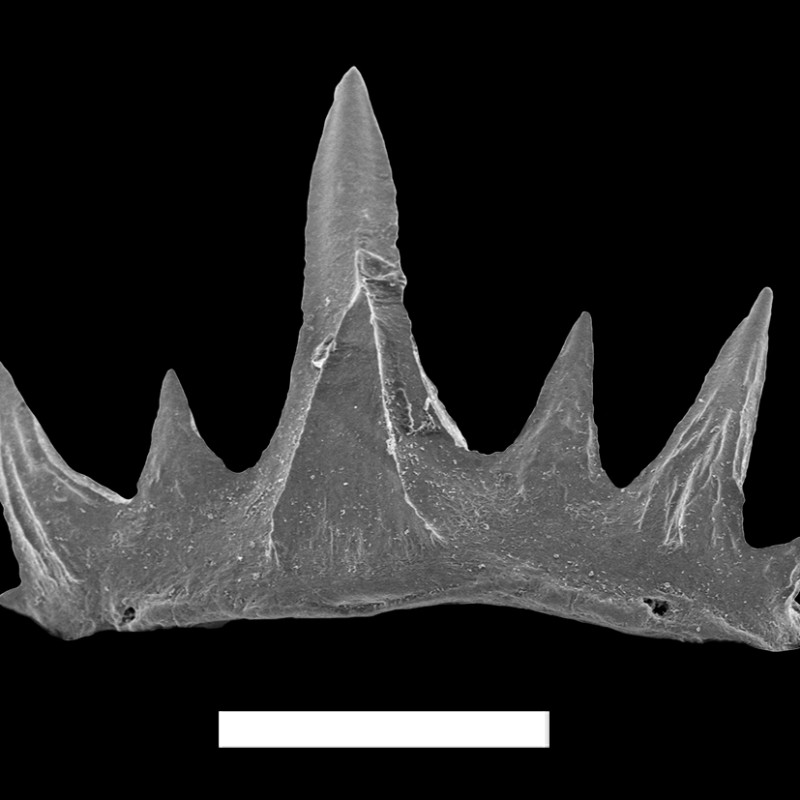Bacteria feed on shark teeth A new study shows that bacteria in the deep sea also use teeth as a food source
01. December 2020
Teeth are one of the most resistant organic materials in nature and can survive for
millions of years. They are often the only evidence of extinct vertebrates providing a wealth of information about their dietary
habits. A new study with the participation of Jürgen Kriwet from the University of Vienna now has found out that teeth of
sharks were already an important food nutrition source for bacteria in the otherwise nutrient-poor deep sea more than 100
million years ago.
Teeth are of particular importance for vertebrates
as they are essential for the acquisition of food. The outer enamel layer on teeth, which is one of the hardest organic substances,
plays an essential role in processing food particles. Almost everyone knows that bacteria can attack and damage this enamel
through their metabolism in the form of caries. However, the formation of caries is an indirect effect and is usually limited
to lesions on the tooth surface. It was therefore all the more surprising to find bacteria within the tooth enamel of fossil
deep sea shark teeth. These fossil bacteria were specialised to actively penetrate the enamel with the aim to get the minimum
amount of organic material that was stored between the hard enamel crystallites. This can only be achieved by complex biochemical
processes, which enable to break down the enamel proteins. In a hostile and nutrient-poor environment such as the deep sea,
however, this effort seemingly makes sense.
Now, a scientific team led by Iris Feichtinger from the Natural History Museum Vienna and Jürgen Kriwet from the University of Vienna, with the participation of other colleagues from the museum and university as well as from the CNRS Orléans (France), has succeeded in demonstrating this unusual food intake for the first time.
The excellent preservation of the fossil bacteria is as sensational as the find itself. "The conservation was made possible by the bacteria themselves. Through chemical processes on the cell surfaces, the bacteria were able to bind tiny clay minerals to themselves. These enevlops subsequently fossilized and survived for millions of years, even though the bacteria had long since decayed," says study leader Iris Feichtinger.
The deep sea is and was a hostile environment where food supply generally is rare. It is here that the final decomposition of bones takes place under oxygen-deficient conditions mainly by microbes and the bone-eating worm, Osedax. The ultimate fate of teeth in the deep sea, however, remained an enigma. "It was previously unknown that bacteria even use the minor amounts of organic matter within the highly mineralised tissues of teeth as a source of food when it is scarce. This discovery therefore is of great importance because it contributes to a better understanding of food webs in the deep sea and shows that microbes not only damage teeth on the surface but also use tiny material weaknesses in the tooth to obtain even the smallest amounts of organic material for energy production," says Jürgen Kriwet. This shows that microbes are very adaptable and creative when it comes to exploit new food sources. Perhaps the destructive activity of these microbes also is one of the reasons why teeth are so rare in deep sea sediments, both today and in the past.
Publikation in Sientific Reports:
Iris Feichtinger, Alexander Lukeneder, Dan Topa, Jürgen Kriwet, Eugen Libowitzky, and Frances Westalle (2020). Fossil microbial shark tooth decay documents in situ metabolism of enameloid proteins as nutrition source in deep water environments. In: Scientific Reports.
DOI: 10.1038/s41598-020-77964-50a66953e-a308-4311-b48d-485ce20cafac
Now, a scientific team led by Iris Feichtinger from the Natural History Museum Vienna and Jürgen Kriwet from the University of Vienna, with the participation of other colleagues from the museum and university as well as from the CNRS Orléans (France), has succeeded in demonstrating this unusual food intake for the first time.
The excellent preservation of the fossil bacteria is as sensational as the find itself. "The conservation was made possible by the bacteria themselves. Through chemical processes on the cell surfaces, the bacteria were able to bind tiny clay minerals to themselves. These enevlops subsequently fossilized and survived for millions of years, even though the bacteria had long since decayed," says study leader Iris Feichtinger.
The deep sea is and was a hostile environment where food supply generally is rare. It is here that the final decomposition of bones takes place under oxygen-deficient conditions mainly by microbes and the bone-eating worm, Osedax. The ultimate fate of teeth in the deep sea, however, remained an enigma. "It was previously unknown that bacteria even use the minor amounts of organic matter within the highly mineralised tissues of teeth as a source of food when it is scarce. This discovery therefore is of great importance because it contributes to a better understanding of food webs in the deep sea and shows that microbes not only damage teeth on the surface but also use tiny material weaknesses in the tooth to obtain even the smallest amounts of organic material for energy production," says Jürgen Kriwet. This shows that microbes are very adaptable and creative when it comes to exploit new food sources. Perhaps the destructive activity of these microbes also is one of the reasons why teeth are so rare in deep sea sediments, both today and in the past.
Publikation in Sientific Reports:
Iris Feichtinger, Alexander Lukeneder, Dan Topa, Jürgen Kriwet, Eugen Libowitzky, and Frances Westalle (2020). Fossil microbial shark tooth decay documents in situ metabolism of enameloid proteins as nutrition source in deep water environments. In: Scientific Reports.
DOI: 10.1038/s41598-020-77964-50a66953e-a308-4311-b48d-485ce20cafac




